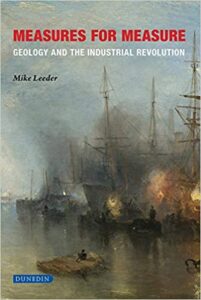By Mike Leeder

I sat down to read this over Christmas and what a good read it turned out to be. The appropriate word is ‘eclectic’ – because Measures for Measure is written for all us with an interest in the industrial history of Great Britain, and its impact on the landscape, economy, social history and culture. It’s a great read as it dots about linking places and ideas together, with the link always being the geology.
I am not sure that it is intended to be a textbook – the author is always too present in the narrative, in particular, his calling out the social deprivation and injustice. That is, the pervasive lack of economic, political and social rights that accompanied much of this country’s industrial ‘advances’, for example, the virtual serfdom of Scottish miners until 1795.
However, as a review in Geoscientist online puts it:
“As geologists, we understand that the Carboniferous rocks of the Coal Measures were essential to the first Industrial Revolution. They determined its location, pace and extent. This book explains not only this relationship but the profound consequences to our landscape, society, culture and economics that followed.”
In fact, coal, iron ore and other metallic ores and materials have been extracted from Carboniferous strata and traded for over five hundred years before the Industrial Revolution, notably since thirteenth century in the ‘London Trade’ of coal from Tyneside. However, it is the industrial revolution, connected to the abundance of fossil carbon preserved in Britain’s Carboniferous rocks, which, in turn, forms the bedrock of the book. That one of the (many) questions, it tries to answer is: Why did the Industrial Revolution originate in Britain in the early- to mid-eighteenth century and not somewhere in mainland Europe, where coal was also abundant?
The answer seems to be the linked geological, economic and social factors that combined to enable the formation, preservation, exposure and exploitation of neighbouring coal- and iron-bearing reserves. In this way, the principal features of the distinctive industrial regions that grew up are traced back to their landscapes and geology, as the great British industrial cities became world leaders, and their entrepreneurs and industrialists became the world’s first mega-rich, immensely proud of their creations. However, at the same time, industrial workers had to fight collectively for economic, political and social rights, and then to cope with the many traumas of de-industrialisation and unemployment.
And now, as the author points out, the surviving machines, buildings and housing of the original Industrial Revolution, based mostly upon Coal Measures strata, still dominate many parts of Britain, but now in family-friendly and informative ways in the guise of industrial museums, reconstructed industrial settlements, preserved landscapes and historic townscapes.
Leeder also points out that our society, and its creative core of literature, visual arts and architecture, were profoundly affected by the whole process. And the British Carboniferous legacy for the world was also profound and permanent, especially since, over the last 60 or so years, carbon dioxide emissions from the use of fossil fuels are causing global warming.
The book is set out in four parts, covering:
- The Economy in Motion, which sets the scene with six cameo sketches of key industrial developments.
- Redress of Time, containing explanations and discussion of Carboniferous worlds, with background geology, climate, botany and geochemistry, for the most part explained in simple but concise English (there is glossary for those more obscure terms.
- Legacies: Carbon Cycling, Chimneys and Creativity, which covers the science of carbon cycling, the history of Britain as the first ‘Chimney of the World’ and the (artistic) creativity this gave rise to, along with the various consequences of fossil fuel burning.
- Landscapes of Industrial Revolution, that is, our industrial heritage and what it can mean to us today, discussed region by region.
Mike Leeder is Emeritus Professor at the University of East Anglia and a former Head of Earth Sciences at Leeds University. In addition, since school, he has taken a keen interest in history, literature and politics, all of which are covered in this book. With Joy Lawlor, he co-wrote GeoBritannica, which contains a story of British geological and landscape evolution and the related creativity of its peoples since Neolithic times.
Measures for Measure: Geology and the Industrial Revolution, by Mike Leeder, Dunedin Academic Press, Edinburgh/London (2020), 350 pages (hardback), ISBN-13: 978-1780460-8-19


